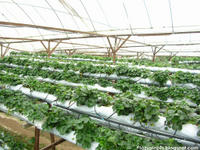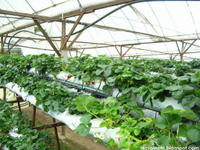It was the last day of our trip. We had breakfast at around 9am and it was still the same choices of breakfast sets: toast with egg or nasi lemak. Since the day before we already tried the former, we ordered the latter this time. Just like the toast with egg breakfast set, the serving for nasi lemak set was just nice to fill up our stomach. Despite the limited choices of breakfast sets, the food wasn't too bad for a hotel.
We checked out at around 10am. Here's the bill for the Family Quad room for 2 nights of stay:
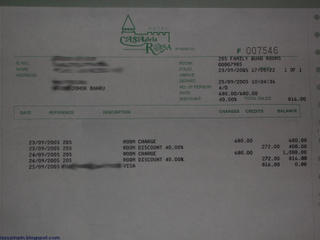
Accommodation cost for 2 nights at RM816, shared by 4 persons.
We then headed to the Raju Hill strawberry farm. Here are the pictures that we took the day before when we visited the farm.
We didn't see a lot of red ripe strawberries. I presumed those should have already been picked and sold by the owner.
We received a lesson on strawberries from Mr Raju the day before:
- Strawberry is a type of fruit that do not taste totally sweet. It always has a sour taste to it.
- At lower land where temperature is high, the strawberries will become more sour and lost its sweetness.
- Rinsing the strawberries with water will make the strawberries turn sour. So we should just eat without rinsing.
- The best way to eat strawberries is to go with whipped cream + icing sugar + honey

This is the way to eat the strawberries, yummy!
Carol and Celia, just like the day before when shopping at the night market, did the "buying in bulk" again. Carol bought 15 packets of fresh strawberries and Celia bought 8, while we bought 2 and Joan 1. We all also bought a lot of strawberry jam since the jam could last for a longer time (approximately 1 year).
We gave them such big business that Mrs Raja gave us free fresh strawberries (with whipped cream and all) to be eaten on the spot. If i remember clearly, i think we had at least 3 rounds of the free strawberries and really ate to our satisfaction.
For big customer like us, they also provided special packing so that the quality of the fresh strawberries and jam can be preserved for the long journey. She placed the stuffs into the iceboxes filled with ice and sealed the boxes. I'm not sure how much this had helped because the strawberries still tasted sour when eaten later at home.
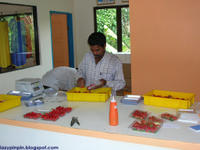
The workers packing the strawberries with hands -- and we were told not to rinse the strawberries? I sure hope he had washed his hands.
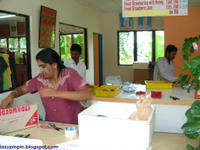

Mrs Raju (i presume) packing our orders into the icebox

We waiting for the packing to be done.
We placed the ice boxes on the backseat, in between Carol and Celia, as the car boot was already filled with things we bought on the day before. We also didn't want the heat in the car boot to accelerate the melting of the ice in the icebox.
It was about time to begin our return journey. Since we didn't visit a vegetable farm at all, we agreed that we would stop by one if there was any on our way back. Celia had mentioned several times that our friend Min told her that we must pay a visit to a vegetable farm that plants water crest. She said that we would be surprised to find out how water crest is cultivated. So we set our eyes to look out for one.
Just a few minutes of driving from Raju Hill, we saw a sign by the road side:

Wow, water crest we wanted, water crest there was. How lucky could we get huh?! We immediately made a turn and stopped at the parking space near the sign.
Although this farm was named "Water Crest Valley", they did plant other kinds of veggie as well, such as this leafy green veggie that was called 茼莴 (tung ho, or chrysanthemum coronarium), a type of veggie that's rather expensive and normally goes with steamboat or soup:

and 金针花 (jin zhen hua, not sure what it's called in English but it's a type of lily flower):


We also saw piles of sweet potatoes
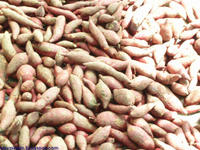
and strawberries as well (hmmm, it seemed like every farm in Cameron must plant strawberries somehow):

Of course, this place wouldn't be called Water Crest Valley for nothing. The main veggie they planted was water crest, which covered a large farming ground.

To see that water crest was planted in water wasn't a surprise at all (after all, it is called water crest). However, what we didn't understand was why there were two different sections where one held the leafy water crest and the other filled with the stems.

The section with leafy water crest
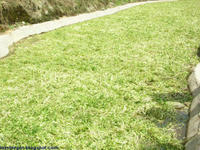
The section with stems of water crest
We understood from the farm owner that after the water crest have been harvested, portion of the stems would be put back to the farming ground for re-growing. The roots would grow from the stems again to become new fresh water crest with leaves.
We were also told that the Chinese herb 田七 (tian qi, or Pseudoginseng) was grown from tree trunks and not from the ground as what we've always thought. I had my reservation on this piece of information because tian qi looked like ginger in black colour. I thought anything looks like that should be roots dug out from the soil instead of something grow on the tree trunk. But then, there was no reason why the farmer would wanna bluff us on it.
So you see, no matter how highly educated one is, there's always new things to be learnt, and sometimes the best way to gain the new knowledge is to leave home and experience it for ourselves.
We left the Water Crest Valley at about noon time and headed home. For some reasons, the roads appeared to be less winding on our way down to the lower land and i didn't feel dizzy at all. Yet, the gradually increasing temperature kinda gave us a headache, especially when it was indeed a very hot day.
We stopped by Simpang Pulai for lunch before we hit the highway. Again, 贝 drove the whole journey, entertained by our tittle-tattle throughout. So, here's a tip for those who wanna travel long distance and driving all the way: have a few ladies in your car with you and there's no way you would fall asleep with all those chattering.
We reached home at around 7.30pm, dog-tired. It was a fruitful and educational trip albeit somewhat marred by the unpleasant incident. Due to time constraints, we had missed some activities such as jungle trekking and visiting the highest peak of Brinchang Hill. I wouldn't mind going back again, even if it's just for the fresh air and strawberries.

Labels: travel
